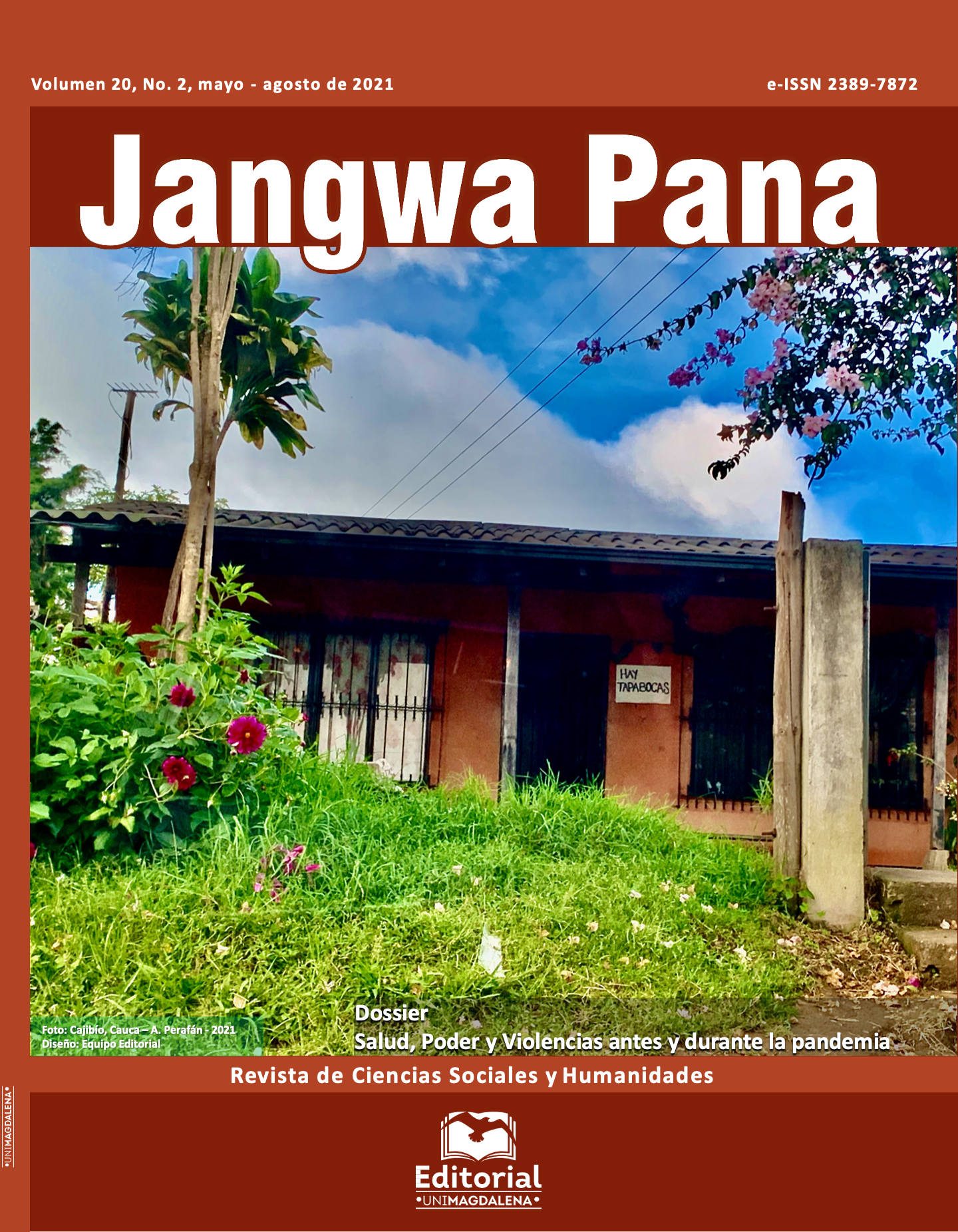Invasive species, health and knowledge in a tropical wetland: interdisciplinary study in Ciénaga de Santo Tomás
Main Article Content
Abstract
Downloads
Article Details
References
Alarcón-Elbal, P. M. (2013). Plantas invasoras acuáticas y culícidos: un binomio peligroso Invasive aquatic plants and culicids: a dangerous duo. Bol. R. Soc. Esp. Hist. Nat. Sec. Biol., 107, 5–15.
ASOCAR & Universidad del Magdalena. (2011). Ajuste del plan de ordenación y manejo del complejo de humedales de la vertiente occidental del Río Magdalena en el departamento del Atlántico y determinación de la ronda hídrica de los humedales de Sabanagrande, Santo Tomas y Palmar de Várela. Santa Marta, Colombia.
Alcaldía del Municipio de Santo Tomás (2020-2023) Plan de Desarrollo Municipal. https://santotomasatlantico.micolombiadigital.gov.co/sites/santotomasatlantico/content/files/000333/16618_v2-plan-de-desarrollo-20202023-santo-tomas.pdf
Alarcón-Elbal, P. M. (2013). Plantas invasoras acuáticas y culícidos: un binomio peligroso Invasive aquatic plants and culicids: a dangerous duo. Bol. R. Soc. Esp. Hist. Nat. Sec. Biol., 107, 5–15.
Atlántico, G. del. (2016). Boletín epidemiológico semanal del Departamento del Atlántico #47. http://www.atlantico.gov.co/images/stories/salud/salud_publica/BES-47-2016.pdf
Becares, E. (2016). Especies invasoras en humedales y su relación con la salud en zonas tropicales. In Especies invasoras acuáticas y salud. Universidad del Atlántico; CYTED.
Bolay, J.-C., Cunha, A., Bassand, M., & Ngoc Du, T. T. (2000). Métropolisation, crise écologique et développement durable. L’eau et l’habitat précaire à Ho Chi Minh-Ville, Vietnam. Presses polytechniques et universitaires romandes.
Carver, S., Slaney, D. P., Leisnham, P. T., & Weinstein, P. (2015). Healthy Wetlands, Healthy People: Mosquito Borne Disease (pp. 95–121). Springer, Dordrecht. http://doi.org/10.1007/978-94-017-9609-5_6
Caselles, A., & Campo, K. (2016). Especies invasoras acuáticas y salud. http://www.invawet-cyted.org/wp-content/uploads/2017/04/memoriaslastversion2017.pdf
Cerro, J., Sarmiento, G., Potes, D., Torres, D., & Arango, P. (2016). Especies de mosquitos (Díptera: Culicidae) presentes en zonas de influencia de humedales en el departamento del Atlántico y Distrito de Barranquilla. In Especies invasoras acuáticas y salud. Universidad del Atlántico; CYTED.
Cerro M, J. A. (2019). Relación de la cobertura de macrófitas, variables fisicoquímicas y microbiológicas con el emsablaje de larvas de Culicidae en la Ciénaga de Santo Tomás, Colombia. Tesis maestría en Biología. Universidad del Atlántico, Barranquilla Colombia.
CRA. (2004). Cuerpos de Agua del Atlántico.
CRA. (2007). Documentación del estado de las cuencas hidrográficas en el departamento del Atlántico.
CRA. (2016). Plan de acción cuatrienal PAC 2016-2019 Atlántico frente al Cambio Climático.
Derne, B. T., Weinstein, P., & Lau, C. L. (2015). Wetlands as Sites of Exposure to Water-Borne Infectious Diseases (pp. 45–74). Springer, Dordrecht. http://doi.org/10.1007/978-94-017-9609-5_4
dos Santos Alberti, T., Zamboni, R., Scheid, H. V., da Rosa Venancio, F., Brunner, C. B., Raffi, M. B., Schild, A. L., & Viégas Sallis, E. S. (2020). Spontaneous poisoning by sprouts of xanthium spp. In cattle in southern rio grande do sul. Acta Scientiae Veterinariae, 48(May), 1–4. https://doi.org/10.22456/1679-9216.99161
García, M.; Muñoz, C; Agudelo, C (2018) “Representaciones sociales de la población local frente a las especies acuáticas invasoras en la Ciénaga de Santo Tomás: Un análisis sociológico a propósito de la migración venezolana.”. COmunicación oral en el Foro de Sociología. Universidad del Atlántico. Barranquilla. (Inédito)
Heraldo, E. (2017, December 14). Dengue, zika y chiunguña se reactivarían por época de sequía. https://www.elheraldo.co/barranquilla/dengue-zika-y-chikunguna-se-reactivarian-por-epoca-de-sequia-435848
Head, L., Larson, B. M., Hobbs, R., Atchison, J., Gill, N., Kull, C., & Rangan, H. (2015). Living with Invasive Plants in the Anthropocene [Article]. Conservation and Society, 13(3), 311–318. https://doi.org/10.4103/0972-4923.170411
Jordan, R. C., Brooks, W. R., Howe, D. V, & Ehrenfeld, J. G. (2012). Evaluating the Performance of Volunteers in Mapping Invasive Plants in Public Conservation Lands [Article]. Environmental Management (New York), 49(2), 425–434. https://doi.org/10.1007/s00267-011-9789-y
Invawet. (2016). INVAWET. http://www.invawet-cyted.org/nosotros/invawet/
Márquez Guerra, J. F., & Urueta, Y. (2018). Olor, normalización y reglamentación: el caso de Las molestias olfativas en la zona industrial de Barranquilla. In Molestias olfativas en la zona industrial de Barranquilla: un estudio socio-técnico interdisciplinario (pp. 67–86). Universidad del Atlántico.
Merlín-Uribe, Y., Contreras-Hernández, A., Astier-Calderón, M., Jensen, O. P., Zaragoza, R., & Zambrano, L. (2013). Urban expansion into a protected natural area in Mexico City: Alternative management scenarios. Journal of Environmental Planning and Management, 56(3), 398–411. https://doi.org/10.1080/09640568.2012.683686
Mougenot, C., & Strivay, L. (2011). Le pire ami de l’homme : du lapin de garenne aux guerres biologiques. https://journals.openedition.org/lectures/5800
Nguyen, N.-A., Eskelson, B. N. I., Meitner, M. J., & Murray, T. (2020). People’s Knowledge and Risk Perceptions of Invasive Plants in Metro Vancouver, British Columbia, Canada [Article]. Environmental Management (New York), 66(6), 985–996. https://doi.org/10.1007/s00267-020-01350-0
OMS. (2017). Respuesta mundial para el control de vectores 2017-2030. http://search.who.int/search?q=ZIKA&ie=utf8&site=who&client=_es_r&proxystylesheet=_es_r&output=xml_no_dtd&oe=utf8.
Pinto Siabatto, J. J., Serrano Donado, A., & Guzmán Acendra, L. (2018). Ciudad de Olores. Experiencia de realización documental como estrategia antropológica de investigación, producción y difusión audiovisual. In Molestias olfativas en la zona industrial de Barranquilla: un estudio socio-técnico interdisciplinario (pp. 130–145). Universidad del Atlántico.
Posada, J. A. (2016). Plantas acuáticas invasivas y su d en Colombia. Universidad del Atlántico; CYTED.
Pozzo, M. . (2020). Variación espacio-temporal de las plantas acuáticas de la Ciénga de Santo Tomás, Atlántico-Colombia. Tesis Biología. Universidad del Atlántico, Barranquilla.
Schindler, S., Rabitsch, W., & Essl, F. (2018). Climate Change and Increase of Impacts on Human Health by Alien Species. In Invasive species and human health. Oxford: CAB International.
Slovic, P. (1993). Perceived Risk, Trust, and Democracy. Risk Analysis, 13(6), 675–682. http://doi.org/10.1111/j.1539-6924.1993.tb01329.x
Villamagna, A. M., & Murphy, B. R. (2010). Ecological and socio-economic impacts of invasive water hyacinth (Eichhornia crassipes): a review [Article]. Freshwater Biology, 55(2), 282–298. https://doi.org/10.1111/j.1365-2427.2009.02294.x
Taylor-Gooby, P., & Zinn, J. O. (2006). Current directions in risk research: new developments in psychology and sociology. Risk Analysis, 26(2), 397–411. https://doi.org/10.1111/j.1539-6924.2006.00746.x
Velasco Santos, P. (2020). El ciclo hidropolítico en Tlahuapan, Puebla: reflexiones en el capitaloceno. Revista Collectivus, 21(1), 1–9.

